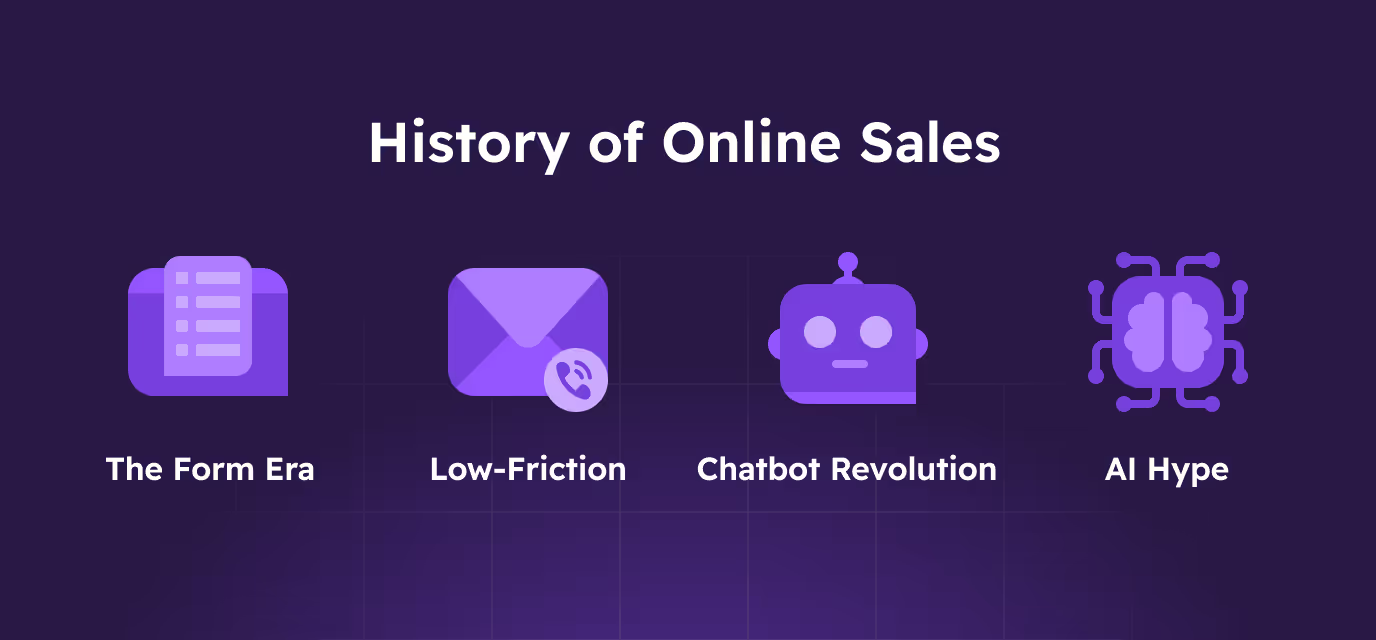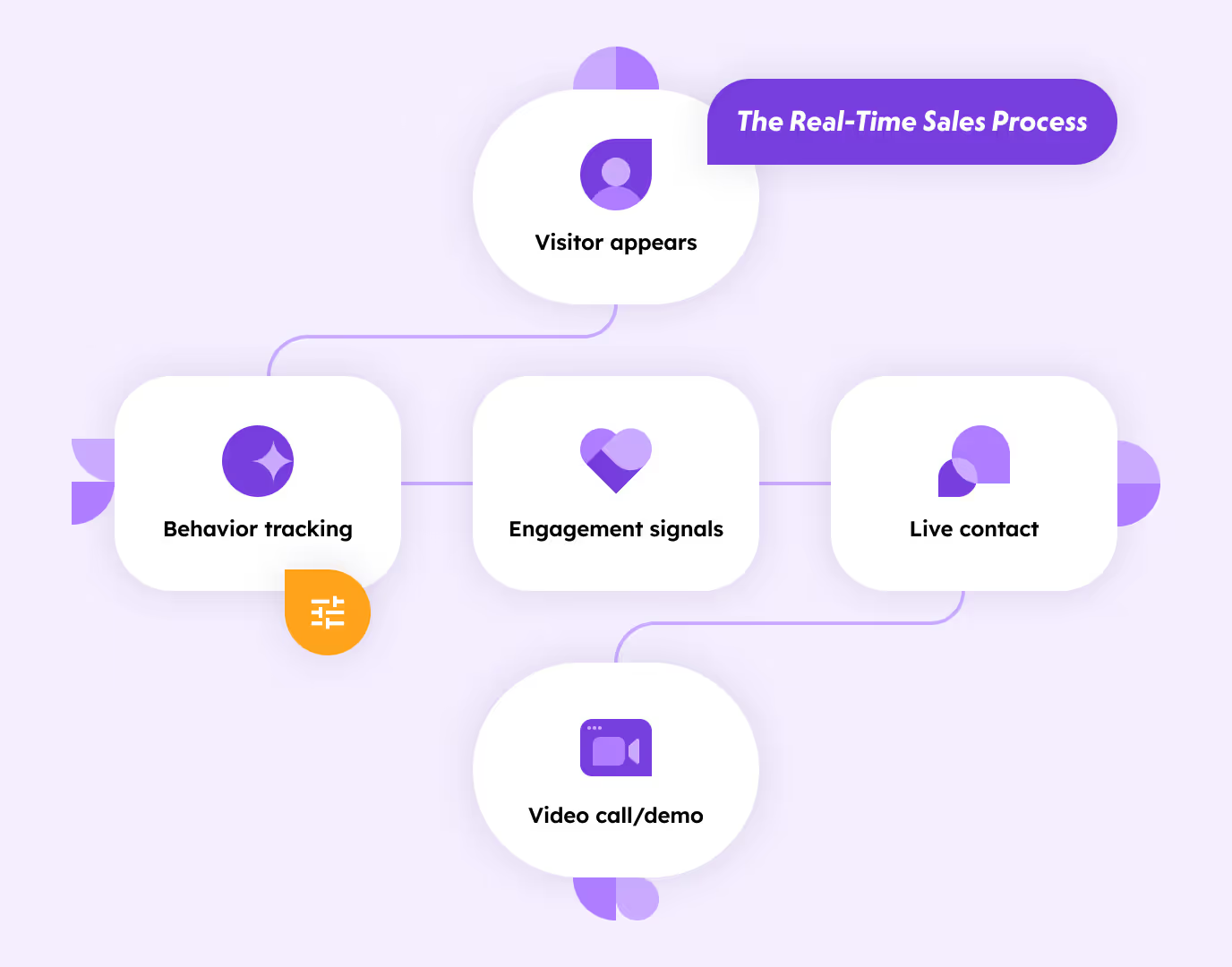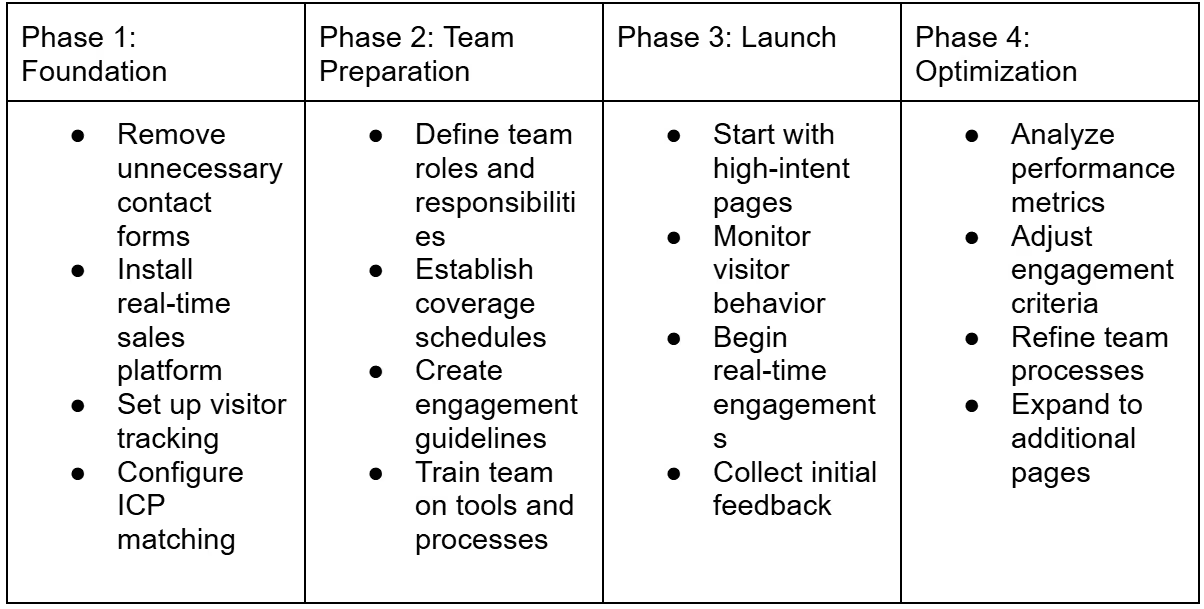Real-Time Sales is The Future of Customer Acquisition


What is Real-Time Sales?
Real-time sales is a modern approach to customer acquisition that enables immediate, browser-based video conversations between buyers and sellers at the moment of highest buyer intent.
Unlike traditional methods that rely on forms, scheduled demos, and multiple touchpoints, real-time sales allow businesses to instantly engage with qualified prospects through video calls and screen sharing directly through their website - no downloads, phone numbers, or contact information required.
In other words, it’s doing what technology has always promised to do: connecting people with other people, in the context of a business relationship.
While virtually every consumer app we use allows for real-time connection whether it comes to chat or video with another person (or more), in the world of sales and customer service, we feel that the opposite is happening. It’s harder and harder to connect with an actual human being, and we are instead forced to move through hoops or battle our way through unhelpful AI agents.
But the data is clear: customers value the human touch. They’ll buy from the company that responds to their inquiry promptly, and they buy from vendors that they trust. So much so, that according to research by Smart.com, 43% of buyers would still prefer shopping in the offline world because they value personal contact, even those who shop online on the daily. This is especially true for high ticket purchases, from cars to real estate and software, where the human touch is of paramount importance.
In light of the above, it is clear to see that somewhere along the way, online sales, especially in B2B, have lost their touch with how buyers want to buy.
We believe that bringing real-time sales via face-to-face human contact to the forefront can fix that. But first, let’s back up a few steps and overview how we ended up in this mess.
The Historical Context

These days, every online interaction seems magical and effortless, even on our mobile devices. But this wasn’t always the case: older readers may have memories of their network connection getting disrupted by a phone call, or having to wait several minutes for a GIF to load.
Our interactions over the web are constrained by the underlying technology, from the speed of the network to the computing power of our servers and devices, not to mention the programming languages and frameworks that are available.
The online buying experience is no different, and it has gone through several stages of best practices as the available technology evolved. In terms of sales, we can talk about the following “eras”:
The Form Era
The earliest form of internet selling, preceding perhaps even credit card transactions. Potential buyers would have to contact the seller via a form to show their interest, and the seller would process those inquiries how they saw fit. The most iconic brand of this era was Hubspot, which wrote the form-driven seller’s playbook.
While this method fit the needs of the times, it has long surpassed its retirement age. Nowadays, filling out forms feels like going through hoops, which creates a lot of friction in the buying process. Worse yet, forms are either too early in the buying process, leading to annoying sales emails euphemized as “nurturing campaigns”, or are too nosy.
But from our point of view, the biggest problem with forms is the downright atrocious lead-response times that they come with, with potential buyers being disqualified and left ghosted altogether by the companies relying on them.
The Rise of "Low-Friction"
Realizing the myriad problems with form-based selling, companies swung the other way with a low-friction, minimalist approach that required a mere email or a phone number from the prospect to book a call. In a way, the low-friction era was the forerunner of the Product-Led Growth (PLG) wave that swept the SaaS industry.
While this saw a rise in call scheduling apps, the approach still had many caveats. Without using forms, the first call between a would-be customer and a sales rep would have to qualify the prospect to see if they’re a right fit, lengthening the sales cycle. Initially, experience-wise it was a step above using forms, but still led to a lot of time wasted for both buyers and sellers, and the dance around scheduling remained an unresolved headache.
The Chatbot Revolution
Long before Sam Altman founded OpenAI, there was a company called Drift that uttered the words “Let there be conversational sales!” and the next thing you knew, every website selling something had a chatbot in their bottom right corner.
The advent of NLP technology allowed companies to deploy smart chatbots that could automatically handle conversations up to a point, answering pretty basic questions that a prospect might have before handing it over to a human. It seemed almost magical at the time, and inbound sales got a huge boost: chatbots seemed like a safe compromise between forms that filter out too many prospects and low-friction interactions that filter out too few bad fits.
These fairly primitive chatbots however failed to live up to the hype, and consumers mostly learned to ignore them. Having a chat window available on your website is still better than the swamp of forms for customers, but this tool has lost effectiveness as customer weariness sets in, as they can’t be sure there’s an actual human behind the screen.
Which brings us to…
The AI Hype
The current iteration of the chatbot revolution. While conversational AI is clearly way above the capabilities of early chatbots, what’s happening now is frankly ridiculous. Not only are companies deploying sales bots on their websites: but they’re connecting them with all the other data sources a salesperson is usually tasked to work with, and automating the entire cadence, from connection requests to outreach campaigns, fully personalized and customized by Gen AI.
At this point, it’s worth remembering that outreach was already a very spammy channel by 2022, and the biggest problem with forms was that they enabled spammy outreach.
The Great Ignore: Why Human Connection Matters More Than Ever
Quipped by Mark Kosoglow, founder of Operator.ai, the Great Ignore refers to the collective response to oversaturated outreach channels like cold calls and emails: we simply ignore them.
With a million notifications trying to vie for our attention every second, the biggest challenge has become focusing on what is to be done. Human attention spans are at the lowest point in history - decreasing by 4 seconds over the last 15 years, down to 12 for millennials and 8 for gen Z. It’s only logical that more and more people are simply ignoring cold outreach, whether it’s done by a human or increasingly by Gen AI.
This means that the old scalable revenue playbook and sales strategies that come with it are decreasing in efficiency to the point that they’ll soon be completely dead.
If businesses want to continue selling, then something has got to change, and that’s where real-time sales come in.
How Real-Time Sales Works
Real-time sales works because human connection becomes all the more valuable in the deluge of automation. The trick is connecting with buyers just in time, when they are in their most engaged state, searching for a solution and inching towards making the buying decision. It is at this precise moment when human persuasion can seal the deal, as no robotic solution has what good salespeople have: empathy for the buyer.
The Technology Behind Real-Time Sales
The tech behind real-time sales combines good visitor data, behavior analytics, and WebRTC-based browser video calling. The idea is that we can guess who the buyer is (and if they match our ICP) in the background and in real-time, then we don’t need to put up forms to gather that information while introducing friction into the buying journey. In addition, by integrating with CRM systems, the paperwork is done automatically as well as providing additional data for the platform to work.
The solution is compliant with privacy regulations and adheres to GDPR within the EU, where individual-level identification is forbidden.
Behavior analytics simply looks at how engaged the buyer is, eg. if they’re on our bottom of the funnel pages, like looking at our pricing page, or they’re showing interest by devouring our blog content on a repeat basis.
.gif)
When their interest is the highest, we prompt them with a live video call through the browser - no phone numbers need to be provided, and meetings don’t need to be booked. Everything happens while they’re still on the website and shopping around.
The Real-Time Sales Process

Process-wise, real-time sales involve an active monitoring of website visitors as they are browsing the site. Visitors who are showing strong engagement signals or match our ICPs should be contacted proactively first via chat while they’re still online, and the seller should initiate the call.
Depending on how strong the match and their interest are, this can range from a simple discovery call that ends with setting up another meeting, to a product demo on the fly with screen sharing.
Benefits of Real-Time Sales
Companies who implement real-time sales see tremendous benefits: we’ve seen a 10x increase in booked demos, with the new process starting to bring pipeline on the same week that it’s implemented. In addition to boosting your bottom line, this has the added benefit of stopping your SDRs from burning out.
The science behind this is that we’ve known for decades that lead response times can make or break a deal: leads contacted after an hour has passed start significantly decreasing the chance of that deal happening.
If you think about it, it’s only logical: when we shop around for solutions, our interest peaks and fades as we move on to deal with other matters. Frequently, the first company to contact a buyer will win the deal, because they are the first to win our trust.
Real-time sales take that to the logical conclusion by making it a magical experience that turns your sales process into something that wows the buyer.
Real-Time Sales Benefits

Real-Time Sales vs Traditional Sales
Traditional sales is mostly a numbers game focusing on contacting as many people as possible by any means possible. Real-time sales is about precision because it takes into account that only at most 5% of our target customers are actually in-market to buy, and even among our website visitors we have to focus on those who have the most interest - when they are the most engaged.
Real-time sales is thus closer to the inbound sales role with specialized tooling and processes fit for the job, working out of the platform directly to engage with buyers who are showing interest.
.avif)
Implementing Real-Time Sales
Implementing real-time sales first and foremost is a shift in mindset. You have to let go of your old methods (and your forms everywhere if you have them) and embrace openness and availability. This means:
- Letting go of traditional form-based gatekeeping
- Embracing direct, immediate buyer conversations
- Prioritizing buyer convenience over organizational control
- Being ready to engage when the buyer is ready
Contact forms shield us from direct human contact and allow the organization to control the pace of the buying process. Real-time sales on the other hand meet buyers where they are, and that means making your team reachable for practically any visitor on the website.
As mentioned before, this requires constant monitoring of your visitors and a dedicated team to handle the inbound flow and do chats and calls, day in and day out.
Of course, you also need to have specialized software. Implementing all the different features yourself from behavior analytics, visitor identification and video calling to work automatically and in real-time is… a difficult challenge.
Fortunately, that’s what Captiwate does. We help you identify your visitors, match them to your ICP, send you (customizable) alerts on Slack, and allow you to call them as they browse. The solution comes with a customizable widget that shows up in the bottom right corner of your website, which gives visitors the opportunity to interact with you on whichever page you decide to show it.
Implementation Phases of Real-Time Sales


